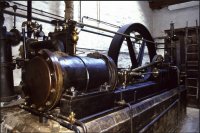








A compound steam engine unit is a type of steam engine where steam is expanded in two or more stages.A typical arrangement for a compound engine is that the steam is first expanded in a high-pressure (HP) cylinder, then having given up heat and losing pressure, it exhausts directly into one or more larger volume low-pressure (LP) cylinders. Multiple-expansion engines employ additional cylinders, of progressively lower pressure, to extract further energy from the steam.
Invented in 1781, this technique was first employed on a Cornish beam engine in 1804. Around 1850, compound engines were first introduced into Lancashire textile mills.
In 1781 – Jonathan Hornblower, the grandson of one of Newcomen's engine erectors in Cornwall, patented a double-cylinder compound reciprocating beam engine in 1781. He was prevented from developing it further by James Watt, who claimed his own patents were infringed.
In 1804 – A method to lessen the magnitude of the continual heating and cooling of a single-expansion steam engine that leads to inefficiency was invented by British engineer Arthur Woolf. Woolf patented his stationary Woolf high-pressure compound engine in 1805.
In 1845 – William McNaught (Glasgow) devised a method of fixing an additional high-pressure cylinder within an existing beam engine. To do so involved using a long pipe to connect the cylinders, and an extra set of valves to balance them. In effect this acted as a receiving chest, and a new type of compound had been invented. This system allowed greater control of the steam intake and cut-offs. An engine could be slowed by either a throttle which reduced the pressure of the steam, or by adjusting the cut-off on either cylinder. The latter was more efficient as no power was lost. The cycle was smoother as the two cylinders were not in phase.
1865 SS Agamemnon (1865) was launched, equipped with a 300hp compound steam engine. The engine was designed by Alfred Holt, one her owners. The efficiency obtained enabled this ship to sail 8,500 miles before coaling. This made her competitive on routes between China and Britain.
In 1861 – Daniel Adamson took out a patent for a multiple-expansion engine, with three or more cylinders connected to one beam or crankshaft. He built a triple-expansion engine for Victoria Mills, Dukinfield which opened in 1867.
In 1871 – Charles Normand, of Le Havre fitted a triple-expansion engine to a Seine river boat in 1871.
In 1872 – Sir F J Bramwell reported that compound marine engines, operating at 45psi to 60psi, consumed 2 lbs to 2.5 lbs per indicated horsepower.
In 1881 - Alexander Carnegie Kirk built SS Aberdeen, the first major ship to be successfully powered by a triple expansion engine.